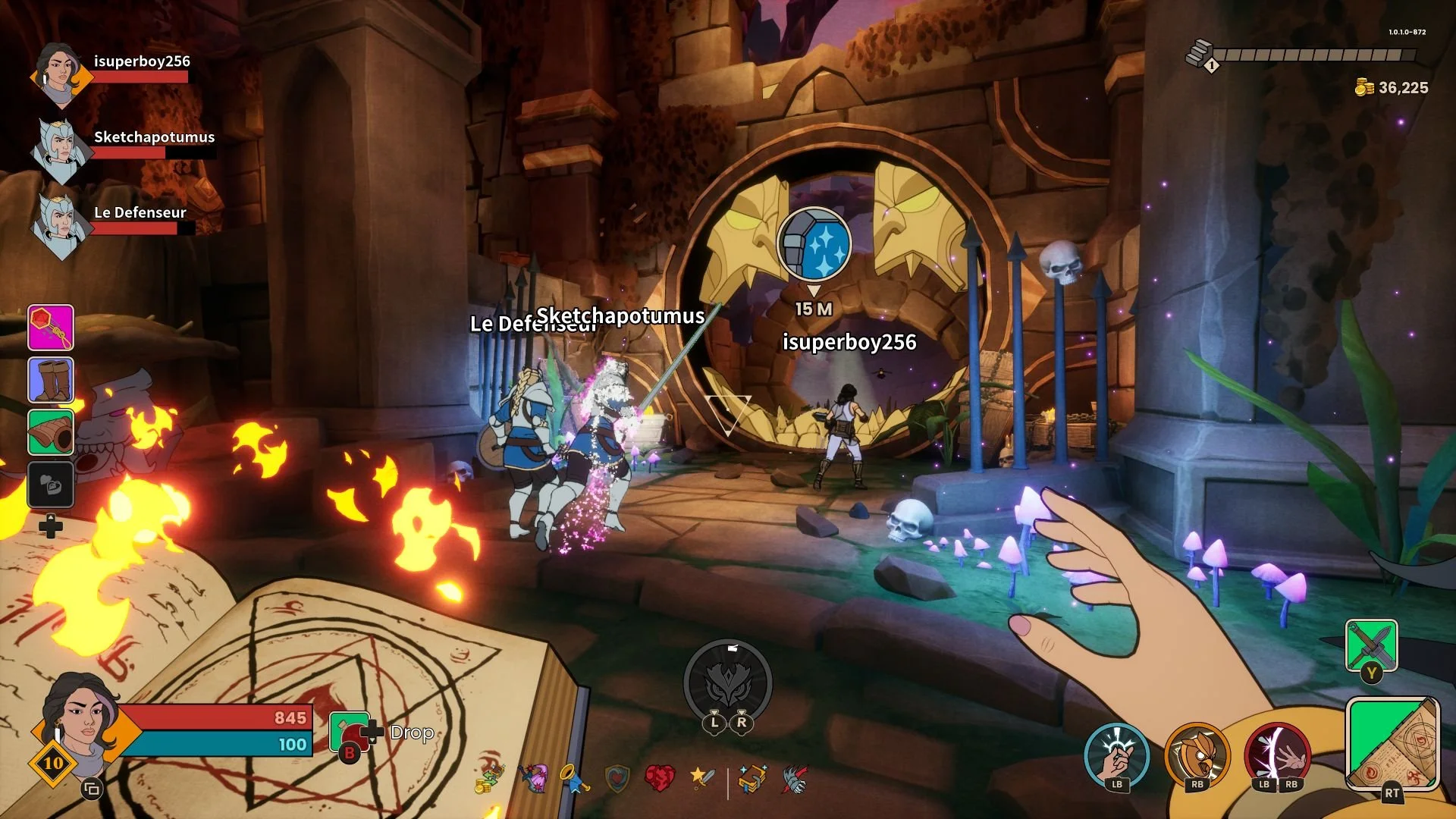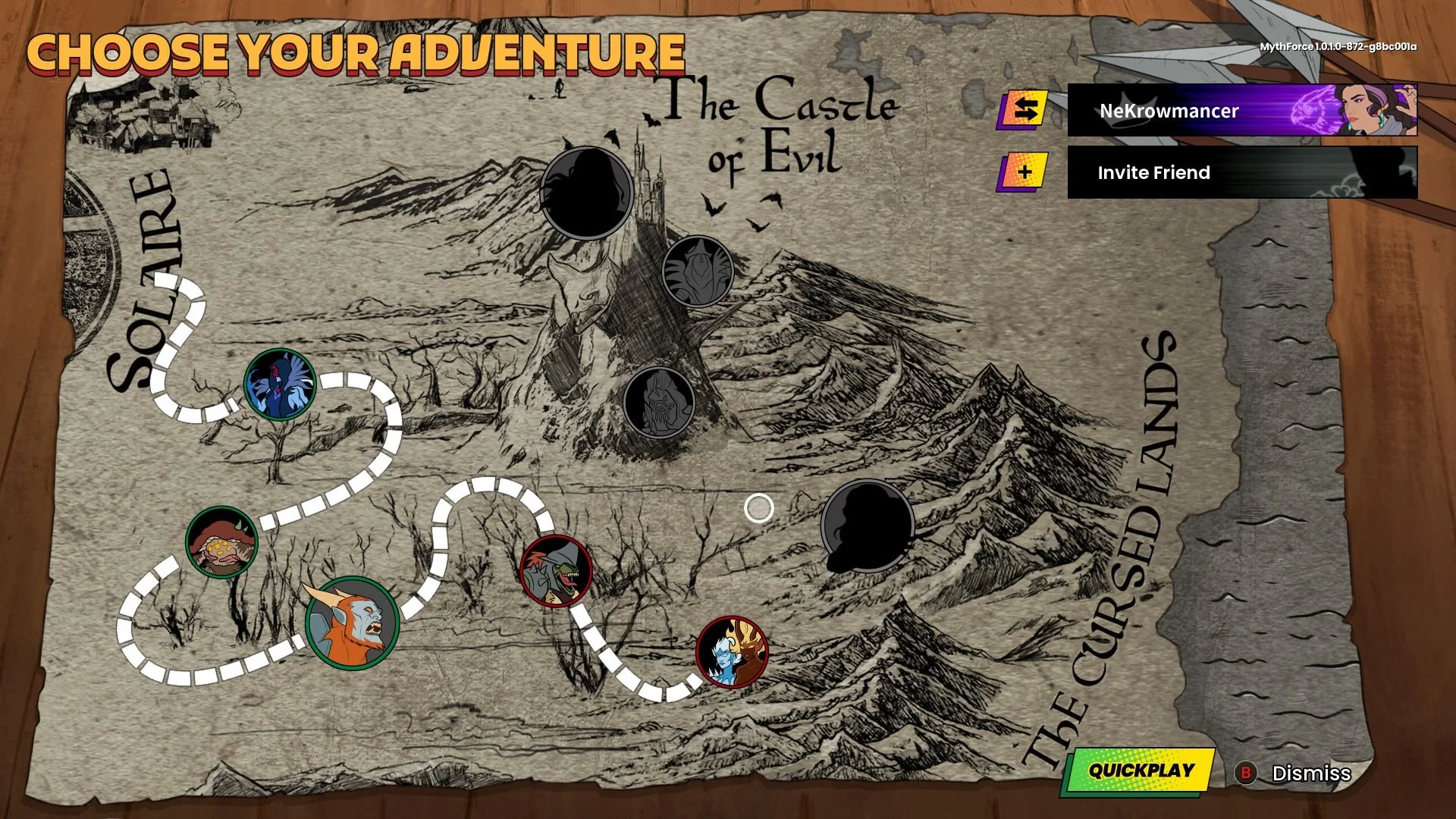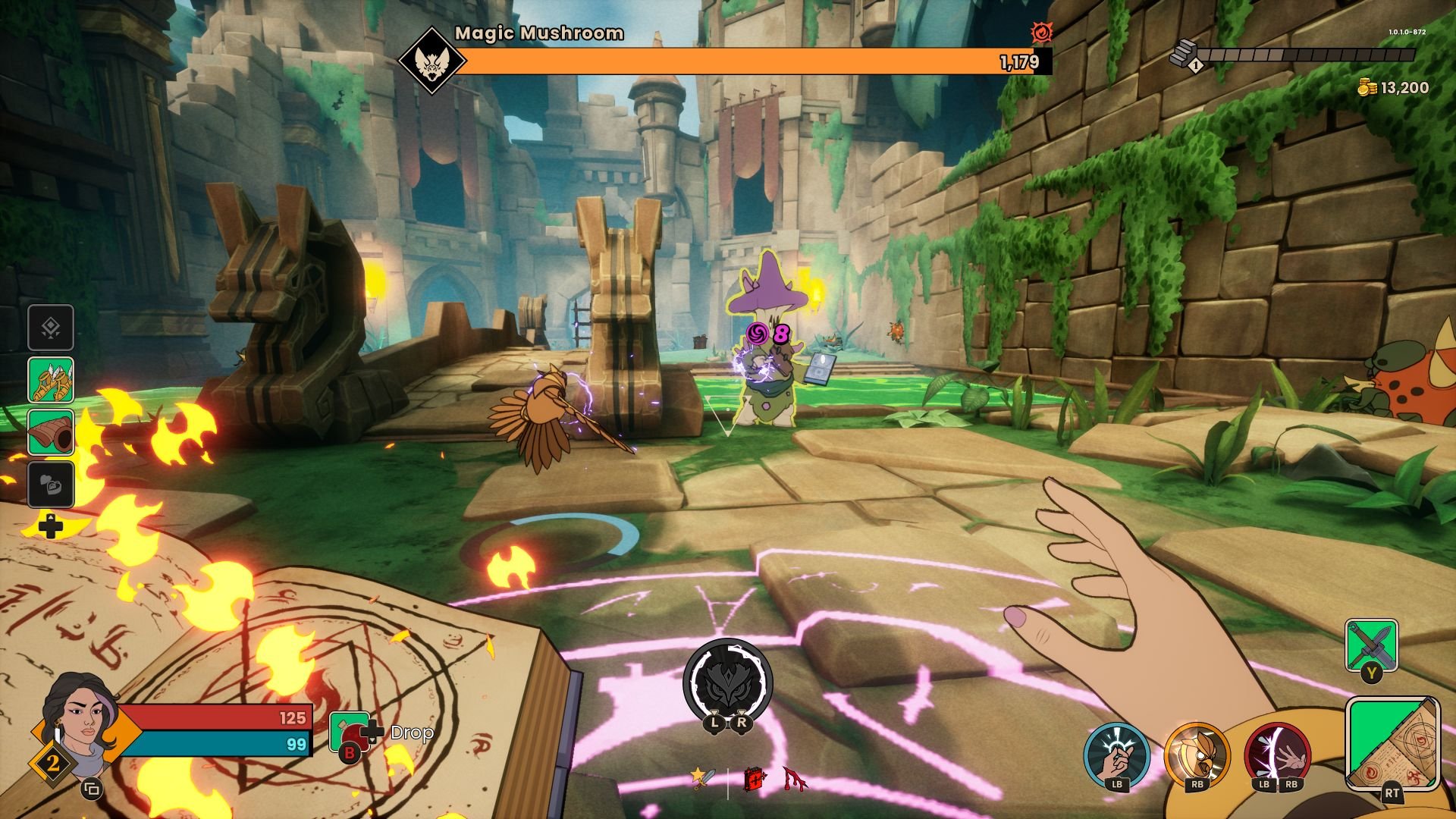Saturday Morning Smackdown.
Within moments, Mythforce was totally my jam. The opening theme pulls from an era of animation I truly adored with one hell of a catchy theme song. Its Master of the Universe influence is everywhere you look. While the gameplay that follows this impressive first impression doesn’t quite keep that same momentum or vibe, Mythforce is nonetheless a fun dungeon roguelike romp whose visuals perform a good amount of the heavy lifting.
As someone who grew up with the Filmmation He-Man cartoon during the 80s, I love the aesthetic and characters present across the game. While its lead villain is a far cry from the design of Skeletor, its Evil-Lyn and Beast Man counterparts certainly live up to their inspirations. While Mythforce is inspired by a great deal of Saturday morning cartoons, He-Man and the Masters of the Universe is certainly the base for the style and design of what this game is shooting for. In fact, if I were to describe Mythforce in a single sentence, it’s He-Man meets Battleborne.
Mythforce is a four-player co-op dungeon crawler that has you hacking and slashing your way through 9 procedurally generated dungeons. You’ll tackle two stages and then combat one of the central bosses as you work your way up to stop the tyranny of the vampire lord, Daedalus. While you can play the game with any assortment up to that four-player scenario, players on the Nintendo Switch are unfortunately locked to two players only, which is rather bizarre, but likely due to hardware limitations.
Presented in a cel-shaded aesthetic that perfectly captures the standard of animation in the early 80’s, you choose from one of four adventurers; Rico the Rogue, Victoria the Knight, Hawkins the Hunter, and Maggie the Mage. Each character is unique in their abilities and powers, from being more focused on close-range attacks or dishing out damage from afar. From throwing your shield, and hurling vortex-sucking attacks, to throwing out a hawk familar, Mythforce provides a good variety of powers that can be tweaked and upgraded as you progress throughout the adventure.
For my main playthrough, I opted for Maggie the Mage. Maggie can throw fireballs and release a protective shield that can buff allies and debuff baddies. She can also throw out a hawk familiar as well that can target enemies to give you time to retreat or explore for treasure. While the one-liners repeat a lot, I found Maggie’s mixture of magic and her off-hand sword to complement one another, especially as you can throw out a fiery spell from afar, setting your enemies ablaze.
Each hero has three basic skills and two forms of attack. You can charge up your weapons which for Maggie has her able to cast both a close-range fire spell or charging it up to launch it across the map with a pretty sizable AOE area. Now, while I say fire spell, you can earn other elemental types such as frozen and electrical options. Abilities are mapped to the LB and RB buttons, with your ultimate attack being LB+RB. You also build up a Mythforce meter which kicks in a few bars of the Mythforce theme as it boosts your attack, replenishes health, and resets all your cooldowns.
Your main attack is RT, with a block with a melee weapon or shield with LT. Y will swap your weapons, even if it doesn’t feel too responsive to do so, often wanting you to wait a full second after attacking with your main weapon. You can also sprint attack as well, but this is only available for melee options and not for Maggie’s spellbook. Characters also have a mobility move as well, which represents the LB portion of your available skills. Maggie can teleport a few feet ahead of her whereas Rico can throw a pocketful of sand at enemies, blinding them so he can get away.
Attacks and mobility drain your stamina, which can be a problem, especially as you are overwhelmed. This drainage can result in your vision going blurry and your inability to attack, making you incredibly vulnerable for a few seconds. While having additional players with you will help contend with the swarm of forces that some chapters can provide, exhausting yourself can make you helpless for anywhere from 5-10 seconds before you can comfortably defend yourself again. And considering there is no mini-map or enemy radar, you can often be blindsided while you are attempting to survive. While upgrades will come as you continue your path of progression, the early game can feel penalizing for all the wrong reasons. I get that you don’t want players to just spam attack after attack, but the harsh limit of your initial stamina is just way too much.
Each of the three acts across the game offers a theme to change it up from the previous chapter as well as an animated sequence to begin that act, but sadly there is not one to end it. Your initial trio of maps takes place in topside ruins, lush with a bright sky and vegetation all around you. This is then followed by digging deeper into underground ruins where you’ll battle against lizardmen and numerous other threats. The final road of missions before your showdown with Deadalus are rather fun, but also follows that same repetitive structure present in the other acts.
Each expedition leads you into an environment where you’ll clear a room, find a shrine, and then move on to the next battlefield. Your progress of rooms is present in the top right, which also has the rooms shown for those that are secret, so you can complete a chapter while still having a few empty slots present. Shrines are placed just before the next room and are there to upgrade your character’s abilities during that run. These vary from Skill Shrines and Mystic Forges, which overall are very similar.
Perks can be earned by interacting with a Skill Shrine. Each time you access this shrine, you’ll receive the choice between three perk cards. Perks are essential upgrades to your character. These enhance your stats or change how certain skills work. Mystic Forges also provides the choice between three cards. Enchantment cards also show you one of your two weapon sets. These add to its power but can also change how the weapon works in combat. While not represented via a shrine, mid-level shops can provide items to buy that change how your special attacks function, leaving you to tinker with your build in some pretty drastic ways.
These entrances also house a revive altar, should your friends fall in combat. Reviving is possible, but the standard revive time is a pretty bizarre ten seconds, and unless you find items or perks that reduce that time, it is nearly impossible to revive your friends during combat. Elsewhere in dungeons, you’ll find healing stations, Gambler Portals that offer up a random item for some gold, and Greed Altars that do largely the same thing but have greater risks attached to them. Lastly, apart from the shops you’ll find as you progress are Kovina’s Crucible, which allows you to drop an item on the platform for a return on some gold.
The levels you’ll explore are procedurally generated and while you’ll tend to see a lot of the same chunks of levels and layouts, complete with secrets in the same places within those areas, they nonetheless flow together rather well. I didn’t mind the repetition of how they are structured since Mythforce is a game where you are meant to retread through these areas time and time again to grind experience and gold to make your character stronger with each passing run. That said, I do wish most segments had been made so that the trio of levels per chapter didn’t feel too similar to one another, especially since you only have 9 levels to explore.
Throughout your exploration, you’ll find a series of trinkets that you can equip. The hub world also allows you to purchase trinkets that will then unlock while playing. These vary from charms to boots to bracers that grant perks such as gaining additional physical defense, earning more gold upon pickup, and your EP reductions for sprinting. This is also the system for the perk shop as well. As you purchase these perks, you’ll unlock their higher-tier versions to appear randomly while adventuring. Each shop will need Glyphs to upgrade them so that you can purchase the more advanced items. However, as each shop’s upgrade costs are a ton of glyphs, this process across only 9 maps is one hell of a grind.
While you’ll have a host of ranged options from numerous spells to your bow and arrow, depending on the character that is, melee is a big focus when enemies get up close and personal. Enemies have a sluggishness to their animations that provide inconsistent tells or clues as to when they will attack. This causes the parry skill to be hard to learn and difficult to master. This led me to avoid most of the melee approach to combat and rely far more on my ranged skills across each of the four characters.
In regards to any issues present in Mythforce, it would be a few annoyances present across nearly every aspect of design. First, it is that each menu system from picking a character to upgrading and buying items is simply unintuitive. The central hub is composed of a few buildings that can be clicked on, but the game doesn’t convey this well enough or even highlight them in a way where you can see the different tone of color that indicates which one you have selected. The constellation upgrade system was something I hadn’t even noticed until well into the second act as it is never once mentioned and is featured as a button press within one of the shops.
I also find it bizarre that there is no character menu or tab outside of a mission. There is no way to check what level you are, even if that was always inconsistent. In one match I would be level 9 then 6 then 2 then back to 7, it never seemed consistent. While the shops thankfully have stars next to their upgrades to indicate what is present, a character menu would be something I would love to see added. I also am not too keen on your gold and items being character-locked and not account-locked. The bounty missions you take on for challenges also don’t indicate which one has been claimed or not, apart from individually clicking them to see if the claimed button is highlighted or not.
While the game can be played in full four-player co-op, any time I joined another player, my choices of Shrine cards were always off. I would select one and it would randomly pick another. This happened across every instance of playing online, it wasn’t just one or two instances, it was every single card. These issues are small things but add up significantly when you start to realize just how many of them there are. I don’t find anything game-breaking, but several of them do impact the experience in ways where I may end up waiting for the title to get a few patches and QOL updates before I revisit it again down the road.
My last nitpick on multiplayer is that while you can invite other players into your game, the ability to join randoms is largely a misfire. You can join a random game, but there is no menu to show you a list of games so that you can find them playing a level that you yourself are currently on. It’s a shame that each level didn’t have its own matchmaking function to find someone to help you where you are at. Having to join a match, find out where they are, and then bounce because it’s the second level all over again is sort of a pain when a simple matchmaking mission list would have made finding the match you want so much easier.
Mythforce despite my issues with it was still a damn fun time. It’s certainly far more difficult than I was expecting, but when you have a full team going, this game shines even with all its blemishes. I think with some updates and some QOL patches Mythforce could be something absolutely incredible, a game that truly lets me live out that 80s saurday morning vibe. Until then, it's like watching the cartoons I taped as a kid, on a VHS tape that is worn out just enough where it gets the job done, but it’s far from perfect.
Developer - Beamdog. Publisher - Aspyr. Released - September 12th, 2023. Available On - Xbox One/Series X/S, PS4, PS5, Nintendo Switch, PC. Rated - (T) - Violence, Users Interact. Platform Reviewed - Xbox Series X. Review Access - A review code was provided by the PR/publisher for the purpose of this review.


















Jeff is the original founder of Analog Stick Gaming. His favorite games include The Witcher III, the Mass Effect Trilogy, Hi-Fi Rush, Stellar Blade, Hellbade: Senua’s Sacrifice, and the Legend of Heroes series, especially Trails of Cold Steel III & IV.